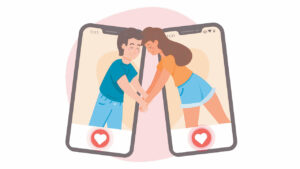Swiping right to forever: A Tinder success story

IT’S A STORY for the times: Boy and Baby Duque (real names of the couple withheld for reasons of privacy) married each other last January in a conventional ceremony, surrounded by their conventional families, after having met quite unconventionally [at least in certain circles] on the dating app Tinder.
“For me, it was an accident. I didn’t believe in it. It was taboo for me,” said Mr. Duque in a mix of English and Filipino in an interview with BusinessWorld not a month after their wedding. In December 2015, during a Christmas party, Mr. Duque’s friends, after learning that he had been single for almost a year, downloaded the app onto his phone. “[For] me, [it was] just meeting new people,” said Ms. Duque. She said that she just spent her time going to work and going home. “I wanted to date.”
While online dating through websites had been quite a thing in the 1990s and 2000s, it had yet to meet the mainstream. With the proliferation of smartphones in the 2010s, so did dating apps, and suddenly, everybody with a smartphone had a way to date with a device that they always brought within their pockets. Tinder itself was launched in 2012, and according to an e-mail from the dating app, the app has been downloaded more than 530 million times. In a nutshell, Tinder works with a user seeing a single profile on their screen, the user then swipes right (“Like”) on their screen if they like what they see, or swipes left (“Nope”) to move on to the next profile. Should two users swipe right on each other (meaning they both like each other), the app allows both to send messages to each other within the app. The next steps are completely up to both the users.
THE RIGHT SWIPES“Congratulations on your friends’ marriage — at Tinder, that’s what we call a swipe story,” said a representative from Tinder in an e-mail to BusinessWorld.
“Dating apps have become a bonafide stepping stone into the dating pool for many singles. Not only are the majority of people under 30 using dating apps according to our data, but over half (55%) have been — and 37% know someone who has been — in a serious relationship with someone they met on Tinder. According to local survey data from the Philippines, a majority (73%) of Filipino Gen Zs are either currently using dating apps or have used dating apps in the past,” said Papri Dev, VP APAC Communications for Tinder, in an e-mail to BusinessWorld.
“The most important factor that can help our members improve their match potential on Tinder is using the app. We prioritize potential matches who are active, and active at the same time. We don’t want to waste people’s time showing profiles of inactive members. We want our members to have meaningful connections, conversations and ultimately meet in real life — and there’s nothing better than matching and immediately striking up a conversation. Using the app regularly helps members be more front and center, see more profiles and make more matches. This is the most important part of our algorithm — and it’s totally in our members’ control,” said Ms. Dev.
Another dating app, one that hit phones in 2014, was Bumble. While it worked similarly to Tinder, it had a novel feature: “On Bumble women must make the first move and initiate the conversation in heterosexual matches (a match made between a man and a woman). This is part of our unique approach to encourage respectful interactions within our community. In same-gender matches, or matches with non-binary people, either person can make the first move,” said Lucille McCart, APAC Communications Director of Bumble in an e-mail to BusinessWorld.
“You select your settings that will inform who you see and who sees you — the basic ones are the gender you are looking to date (men, women, non-binary people or everyone), age and distance. There are also Advanced Filters available as part of our Premium subscriptions that allow more selective members to filter by height; star sign; education; whether the potential matches smoke, drink alcohol or exercise; religion etc.,” she added.
“Aside from current location and gender, it’s just age, distance and gender preferences to start. Proximity is a key factor — it’s always fun meeting someone in the same neighborhood and that’s why we consider a potential match’s distance from a member’s current location,” said Ms. Dev. “For those who want to share more, Tinder factors in interests and lifestyle descriptions members add to their profiles. We also use anonymized cues from photos to help tailor recommendations — we suggest profiles with similar photos to ones members have Liked before, and show their profiles to more people who have Liked members with photos similar to their own. And of course, Likes and Nopes are obviously key pieces of insight into what members like. We are constantly honing the potential matches members see based on how often their profile — and all profiles in their area — are Liked or Noped.”
On that note, the Duque couple told BusinessWorld why they swiped right on each other. “Well, of course, one, maganda (she’s beautiful). We’re not going to lie. Very nice smile,” said Mr. Duque. He also said that he liked what he saw on Ms. Duque’s Tinder bio: she liked basketball and invited potential matches to watch basketball games with her. “Maganda personality (she also had a nice personality).” Ms. Duque said that it was also her now-husband’s smile (and her preference for men with East Asian features) that made her swipe right. “Buti na lang maganda iyong smile ko (thank goodness I have a great smile),” Mr. Duque joked.
The priest during their wedding recalled that Ms. Duque expressed a preference for Ateneo de Manila University (ADMU) and University of the Philippines (UP) graduates, while Mr. Duque graduated from the University of Sto. Tomas (UST). “We wouldn’t have met, to be perfectly honest,” Ms. Duque said when asked if things would have been different if they had met outside the app. “We were moving in the same circles, but I don’t think we would have bumped into each other,” she said in a mix of English and Filipino. “I come from a strict, conservative family,” she said. “You didn’t get the opportunity to go out as much,” her husband interjected. Ms. Duque balked at her husband’s assessment, but he added, “Hindi lang naman ikaw eh. Dito sa Philippines, maraming ganiyan (It’s not just you. Here in the Philippines, there are a lot of families like that).”
“It would have been really hard to meet her, actually,” said Mr. Duque. Ms. Duque says in a mix of English and Filipino, “I think that’s common with people using apps. It’s special when you meet someone, because normally you wouldn’t have met them, ever.”
Mr. Duque said that he asked for her phone number just after a night of talking while on the app — and deleted the app immediately after transferring their conversation to instant messaging app Viber. During a trip to Sagada with friends and family, Mr. Duque found himself waiting for her messages. “How do you explain that feeling? You just want to receive a message from that person. I hadn’t met her physically,” he said. On top of mountains, surrounded by some of the people he loved the most, “Ang nasa isip ko pa rin, siya (the only thing in my mind was her).
“Even if I wouldn’t admit it to myself that time, but right now, when I think back on it, most probably, I’d already fallen for her… that’s just the start of it. Of course, over the course of the years, it grew. Of course, when we met… but doon pa lang, alam ko na eh (but even then, I knew).” For her part, Ms. Duque said that she knew she loved him when, “Gusto mo ibigay iyong same level of happiness sa kaniya, kasi nabibigay niya iyon sa akin (You want to give the same level of happiness he gives you, because he gave that same level of happiness to me).”
HOW DO PEOPLE FALL IN LOVE?Geoffrey Mercado, a Part-Time Lecturer at ADMU and International Baccalaureate Psychology Teacher, tried to explain what Mr. Duque, and so many other poets and singers have tried to do over the centuries: how do people fall in love?
“Specifically, how we fall in love is a biological and intuitive process. From an evolutionary perspective, attraction is necessary for survival and reproduction. Therefore, our bodies are built to be attracted to someone, preferably someone who has a compatible immune system makeup so that our offspring can have a well-prepared immune system,” he said, citing Hakkarainen et al.’s 2021 paper, “MHC Class II Heterozygosity Associated With Attractiveness of Men and Women.” From Donatella Marazziti et al.’s 2017 case report “Serotonin and Love: Supporting Evidence From a Patient Suffering From Obsessive-Compulsive Disorder,” Mr. Mercado gleans that, “In fact, a person who has fallen in love with someone shows the brain chemistry of someone who has a diagnosis of Obsessive Compulsive Disorder (OCD). In other words, the intrusive thoughts of a beloved and the compulsion to act on these thoughts of someone who’s in love are similar to the symptoms being suffered by patients seeking treatment for OCD. There might, indeed, be some truth in the phrase “You’re MADLY in love.’”
Mr. Mercado cites other hypotheses, including one from the study “Perceived, not actual, similarity predicts initial attraction in a live romantic context: Evidence from the speed-dating paradigm” by Natasha Tidwell, et. al in 2013. “From a cognitive perspective, there is a similarity-liking hypothesis that has the most empirical support. How this explanation goes is that we find those who are similar to us to be much more attractive than those who are opposite. The idea is that similarity provides predictability and familiarity, and that leads to feelings of safety and security. However, it’s not actual similarity that leads to attraction but a perception of it,” he said.
“To put these two perspectives together, it looks like our mind and body work together to find us someone — anyone — to connect with. Now, the research on attraction might give the impression that the reasons we fall for people are shallow and silly, but the consoling fact is that we don’t have to end up with those whom we initially found attractive,” he added. “Attraction is a universal process, and it follows the same patterns even if the attraction is towards someone we see on a screen.”
A TINDER SUCCESS STORYIn light of what both Duques said about giving each other the same level of happiness, as well as allowing their love to grow through the years (the Duque couple met on the app in 2015, met in face-to-face in 2016, and married in 2024), Mr. Mercado gave a few thoughts on what makes relationships successful.
“Long-term relationships are considered successful when they are deliberately maintained by both partners,” he said. “Most people find it surprising that they have to put in the work when they’ve met ‘the love of their life,’ thinking that love should come ‘easy’ when it’s ‘true.’ If it takes work, then it somehow shatters their expectation that true love should be a happily ever after. Yet, as the research will tell us, true love has more to do with choosing to stay with someone, especially when the love chemicals formed during the attraction stage have now stabilized. The love becomes true as a consequence of the relationship rather than a prerequisite for it.”
Also important is self-disclosure within a relationship, app-generated or otherwise. In this case and many others, honesty turns out to be the best policy, as the old adage (frequently forgotten in these times) goes. “Self-disclosure is the act of revealing personal, and sometimes damning, information about ourselves to a select few,” said Mr. Mercado. “The idea is that our relationship is considered ‘close’ when we have access to information about the other person that’s close to the center of who they are. Think about it: we have a ‘close’ circle of friends because only they know our deepest and darkest secrets. Similarly, relationships maintain their status when couples regularly disclose intimate information about each other,” he said. “Self-disclosure is about sharing information that has the potential to break the relationship, but having hope that it won’t. This style of communication, as you can see, is a necessary first step for the other maintenance behaviors to occur. We can’t know how the other wants to be loved if we can’t confront the possibility that we’re not doing enough.”
This same behavior is what the Duques think they did right, which is how and why they ended up with each other. Ms. Duque said, “I think we were honest with each other, that we wanted to date each other.” Mr. Duque said, “We were honest about everything.”
“Users should be true to themselves when they’re using the app,” Mr. Duque said. “People should embrace more of what is real about themselves,” he added.
Cool profiles might get more swipes, but he said that maybe, while authentic profiles may get less swipes and therefore, less chances of approval and attraction from another user, “You know that that person appreciates who you are.”
Mr. Mercado says, “Attraction is just the initiation stage of the relationship. Who we talk down the aisle towards, who we raise kids with… who continues to choose us despite all of our flaws is still well within our reach… it’s a set of skills anyone and everyone should spend time learning. I believe that relationships, or how to foster them, should be part of the curriculum in schools because, eventually, relationships are what we will spend most of our lives searching for and maintaining. In the end, I think that relationships should inspire us to become better people, not bitter people, and it shouldn’t matter how and where we find them. What matters is that we recognize that what’s worth keeping is worth working for.”
Ms. Duque reflects on how meeting her husband on Tinder has changed her mind about how love works. “It’s a real leap of faith. It was taboo at that time for most people, but you did it for yourself, because you wanted to try something new… and then you find someone who changed your life.”




